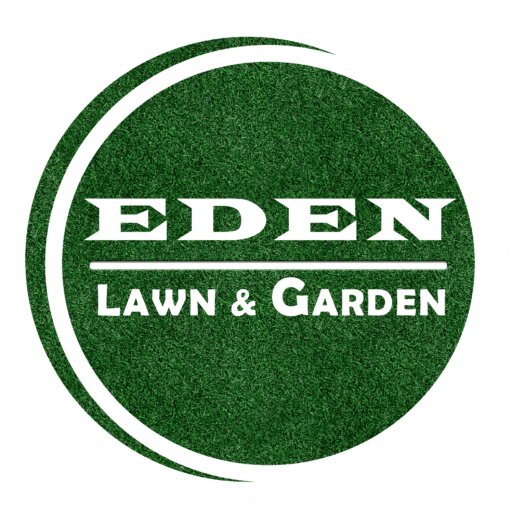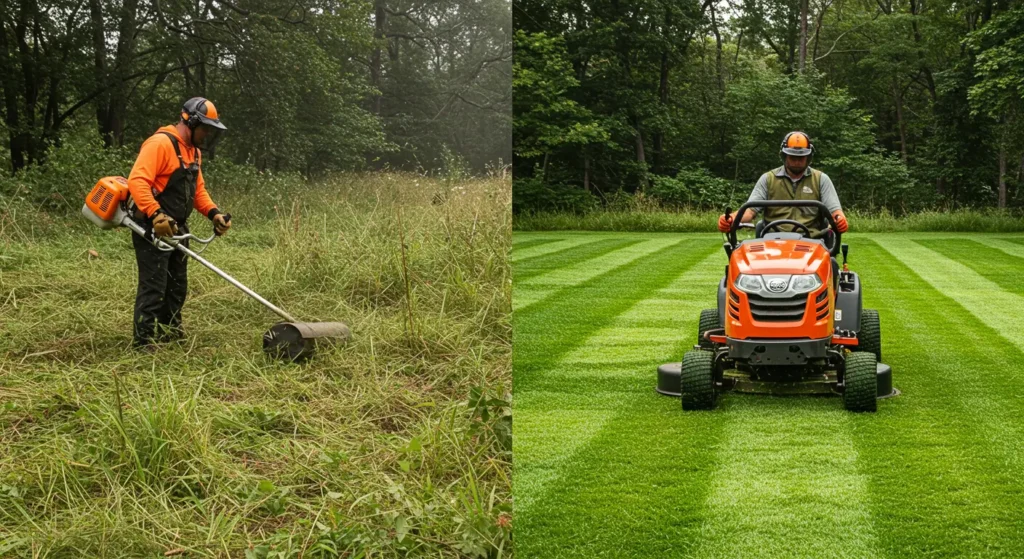I’ll never forget the site visit that changed the way I advise my customers. A client had spent a small fortune replacing mowers that “kept dying.” The machines were repaired once, twice then sold off. She assumed the problem was brand quality. When our landscaper walked the property, he didn’t see bad luck or poor service — he saw mismatch.
The property was rough: long, woody grasses, saplings at the margins and a slope with scattered rocks. Each replacement mower was a fine garden tool but none were made for that battlefield.
We recommended a brush cutter to reclaim the land, followed by regular mowing with a ride-on where lawns were established. The client saved thousands in repairs and replacements and finally had the tidy lawn she wanted.
This article will help you avoid that same mistake. Read on if you want a clear decision framework: when to use a brush cutter, when to use a lawn mower, the costs, safety tradeoffs, and smart combos that keep your yard looking great without wasting money.
Quick summary: the simple rule
- Use a brush cutter for: overgrown land, woody weeds, saplings, thick stems and rough edges.
- Use a lawn mower for: maintained lawns, regular grass cutting, striped finishes, and fast wide-area work.
- Best strategy: clear with a brush cutter, then maintain with a mower or rent/borrow the right machine for occasional heavy jobs.
What each tool actually does (and why it matters)
Brush cutter, the heavy-duty trimmer

A brush cutter is a powered handheld tool with a metal blade or heavy-duty cutting head. It eats through thick, fibrous plants, woody stems and rough pasture that would stall a lawn mower. It’s portable, versatile and built for reclaiming land.
Strengths: tackles tough vegetation, reaches around obstacles, cheaper to buy than most ride-ons, excellent for edges and slopes.
Limitations: slower for large areas, rough finish (not for lawn aesthetics), more physically demanding and needs PPE (gloves, eye and ear protection, long trousers).
Lawn mower – the finish specialist

Lawn mowers (push, self-propelled, ride-on, zero-turn) are designed to cut turf evenly and quickly. They give the neat, uniform finish we associate with healthy lawns. Deck width, engine power, and drive type determine how much ground they can cover comfortably.
Strengths: fast, neat finish; efficient for maintained grass; various deck sizes for different areas.
Limitations: will clog, bog, or stall on very tall/woody growth; limited in rough terrain and tight edges without add-ons.
Cost comparison; purchase, maintenance and hidden costs
- Brush cutter (handheld): usually a lower upfront cost than a ride-on mower. Lower deck of tools to buy; replacement blades and fuel are main costs.
- Push / self-propelled mower: mid-range cost; cheaper for small yards but operating time increases on larger sites. Maintenance includes oil, filters, blades.
- Ride-on / zero-turn mower: highest upfront cost and maintenance, but fastest for large areas and very cost-effective when used frequently over big lawns.
Hidden cost to watch: buying the wrong tool. Repeated repairs, downtime, and replacement purchases add up far faster than hiring the correct machine once.
Safety & legal considerations
- Brush cutters throw debris — always use eye protection, sturdy boots, hearing protection, and long pants. Consider local regulations about noise and operation times (especially in residential areas).
- Mowers (especially ride-ons) require training for safe use on slopes and near edges. Secure loose items, avoid steep slopes without rollover protection, and don’t mow wet grass when traction is poor.
- Insurance: if you run a landscaping business, confirm your liability insurance covers brush cutter work and machine operation on client sites.
Decision framework: choose by ground condition and goal
- Is the area maintained turf (regularly mown)? → Lawn mower.
- Is the area overgrown with woody weeds, tall grass, or brush? → Brush cutter first.
- Is the site large (0.5 acres / 2,000 m² +)? → Ride-on mower for established lawn areas; consider contractor or rental for initial clearing.
- Are there lots of obstacles, narrow paths, or steep slopes? → Brush cutter + follow-up manual trimming; mowers struggle in tight, obstacle-dense areas.
- Is finish important (striped, manicured look)? → Lawn mower is required after clearing.
Real-world combos that work (and save money)
- Small urban lot with patchy growth: brush cutter to clear ragged patches → self-propelled mower for weekly maintenance.
- Large estate with pockets of rough land: hire a brush cutter/clearing service once → invest in a ride-on for regular lawn upkeep.
- Contractors & landscapers: carry both a powerful brush cutter and a commercial walk-behind mower; use the brush cutter to reclaim sites and the mower for finish work.
When renting beats buying
If you only have one big clearing to do per year, rent the brush cutter or a commercial clearing mower. Renting a ride-on for a weekend can be cheaper than buying and storing a machine you’ll seldom use. Eden’s team can advise on rental partners and local options.
Maintenance tips to protect your investment

- Brush cutters: check and replace cutting blades, keep the drive shaft greased, clean air filters, and use the correct fuel/oil mix where applicable.
- Mowers: sharpen blades regularly, check belts, keep cooling fins clean (especially in dusty climates) and service the engine per manufacturer schedule.
- Storage: dry, ventilated storage prevents corrosion and fuel degradation.
Cost-saving, safety-first checklist (for buyers)
- Assess the yard area and growth type before buying.
- If unsure, take photos and consult a specialist (Eden offers pre-buy advice).
- Consider renting a clearing machine if the heavy work is occasional.
- Budget for PPE, spare blades, and regular servicing.
- Train any staff or family members who will operate the machines.
Final word: pick the right tool, not just the cheapest
The lesson from that client’s property is simple: tools must fit the task. A brush cutter is the muscle; a lawn mower is the finisher. Use them together and you’ll save time, avoid wasted repair bills, and get the result you actually want.
If you’d like, Eden Lawn & Garden Centre can:
- Help assess your property remotely (send photos) and recommend the right tool.
- Recommend models for small yards, mixed-use plots, and large estates.
- Arrange rentals for one-off clearing jobs or supply brush cutters and mowers with servicing packages.
Want me to now recommend 3 specific machines (small, medium and brush-cutter option) from Eden’s current stock based on your typical yard sizes with short pros/cons for each? Send me the area (m²) you normally work on and I’ll match models right away.







